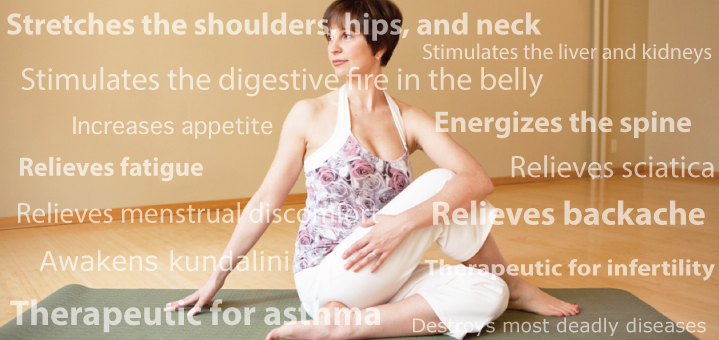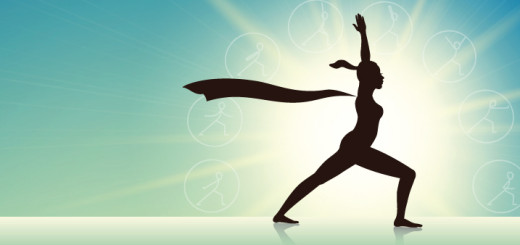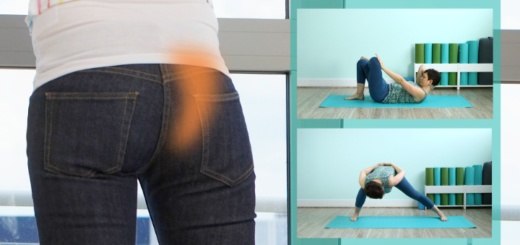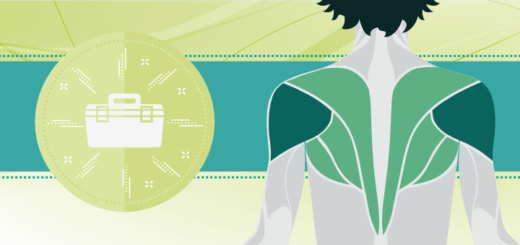Myths about benefits of yoga poses – how much truth is there?
13Let me tell you a secret – many claims that yoga teachers and yoga publications make about benefits of yoga poses are not true. I know, I know, this is really disheartening. We want to believe that yoga is a magic bullet that can cure pretty much anything. Wouldn’t that be nice? The funny thing is – yoga tradition is very powerful, just not in a way that is usually presented. How come? Let’s explore.
Today we will cover some major claims that are being made about benefits of yoga poses and the truth behind them.
Claim 1. “This yoga pose will take care of X,Y,Z”
If you go to a Pose section of Yoga Journal website, for example, you will see that each individual pose is assigned a multitude of benefits. Let’s look at Ardha Matsyendrasana (Half Lord of the Fishes pose). It is said to have the following benefits:
The truth: Let’s examine those one by one.
1. Stimulates the liver and kidneys – this is understandable. Any twist will increase circulation to those internal organs.
2. Stretches the shoulders, hips, and neck – this is also true. All those structural benefits can be achieved with this pose. It’s missing the most important one though – this pose helps to realign the relationship between the shoulder girdle and the spine, which means alternately stretch and strengthen the muscles between the shoulder blades and your spine. This is super useful when you are working with neck/upper back tension.
3. Energizes the spine – I don’t know what that means. This pose is a twist, which means that it rotates the spine. Rotating the spine helps increase circulation into the intervertebral discs, which is a good thing. Is that what “energizes the spine” means?
4. Stimulates the digestive fire in the belly – this is a traditional idea that usually manifests in twists being used widely to aid in digestion and elimination. Makes sense.
5. Relieves menstrual discomfort, fatigue, sciatica, and backache – OK, now we are overreaching a bit. What it really means is that for certain people, under certain circumstances, combined with certain other poses placed in a certain order, this pose might be helpful for menstrual discomfort, sciatica and backache (I still don’t know why fatigue got in there). Or it might not work at all.
6. Therapeutic for asthma and infertility. I am not sure where that came from. This is a perfect example of confusing the dimensions of the human system. In my tradition it is pretty clear – got a structural problem – use poses; got a physiological issue – use breath (and simple poses); got a mental problem – use chants, meditation, text study, etc. Asthma is definitely in a physiological category and needs to be treated as such. And infertility is a very complex issue that is highly individual and requires a thorough investigation. Doing a twist to increase blood flow to the ovaries is a very simplistic way of looking at it.
7. Traditional texts say that Ardha Matsyendrasana increases appetite, destroys most deadly diseases, and awakens kundalini – traditional texts are often poetic and sometimes grandiose in their list of benefits, so we will leave this one alone. 🙂
Bottom line: Yoga poses rarely work in isolation. By themselves, yoga poses DO have certain structural and energetic effects that can be enhanced by combining them a certain way. But for physiological and mental-emotional issues they simply cannot replace the other elements of yoga: breath awareness, pranayama, meditation, chanting, etc.
Claim 2. “Do these three poses to cure X,Y, Z.”
I am a big fan of short yoga practices (we call them “yoga snacks”). In fact, I believe that it is more useful to do 10 minutes of yoga every day then 1 hour once a week. When you do short yoga practices regularly, it actually has a potential to change your life (for the better). But there is a difference between offering “yoga snacks” for long car rides, jiggly thighs or even a hangover, and yoga snacks for diabetes, depression or fibromyalgia. It’s even worse when someone promises to “cure” you of those diseases. My husband works in the public health field and in his world if you make a claim that “something cures something”, you better have ample research published in peer-reviewed journals to back it up. That’s why his field is respected. In the yoga world, on the other hand, folks make those claims all the time, often with anecdotal evidence. That is why our field is not respected.
Another issue that pops up here is that there is often no rhythm or reason to those kind of practices. It becomes just a collection of poses without any logic in how they are organized and no preparation/compensation for the more difficult ones. That is just plain dangerous.
The truth: Will yoga poses cure diabetes? No, they won’t. Can yoga help with managing the symptoms, encouraging healthier lifestyle and better attitude toward the condition? Absolutely. But three random poses won’t be enough for that.
Bottom line: “Yoga snacks” for minor aches and pains, moods and general maintenance are super useful. Just make sure that there is logic in how they are arranged. But please do not try to resolve complex health issues with 10-minute yoga practices from YouTube. Seek professional help. (Look up experienced yoga therapists in your area).
Claim 3. “This routine will work for everyone who has X condition”.
Even when we create complex thoughtful routines to manage a certain condition, there is no guarantee that it will work for everyone who has that condition. In fact, it most certainly will not. Even if you and I have the same health problem, for you it might manifest as migraines and lack of energy, and for me as sleep issues and irritability. Should we do the same practice? No. We always have to remember that we are not dealing with some abstract textbook thing here, but with a person who has it. Therefore, the practice should take into account this person’s health history, symptoms, lifestyle and many other factors.
The truth: This is what yoga therapy is about. It is about figuring out who you are as a person and what challenges you face, and then adapting yoga practices to help you feel better physically, energetically and mentally. We’ll talk more about private yoga sessions next time.
Bottom line: Find a yoga therapist who is interested in you as a person, instead of zeroing in on your condition.
I like yoga poses as much as the next person. But very much like music, their strength is not in individual notes, but in how you combine them to create a melody. Some yoga practices end up as a cacophony of sounds, and some become powerful and life-changing symphonies.























Really happy to see a post like this. I think it’s REALLY important that yoga teachers do their own research and understand the benefits of each yoga pose and not feed our students wrong or exaggerated information. I am myself guilty of saying certain things in class that aren’t true and overreach the benefit of a certain yoga asana.
THANK you for this post and the education!
Thank you Aparna! I think we say those things because of wishful thinking on our part – we really, really want those poses to work for everything 🙂 Got to be accountable for those things though…
An excellent article. Thank you! I love your site. Keep up the great work.
Thank you Barbara!
Thank you that is interesting
You are welcome Debbie!
Thanks Olga for this post. A wonderful insight into why I loved practice with you when you lived in Portland. I miss Saturday informational classes and am grateful to have access to Sequence Wiz’s info. As you know I have spinal curvature, and a daily short 20 minute practice of breathing, forward bends, dog, and shoulder work helps me to stay out of pain. Grateful I can continue to receive yoga information from you!
Hi Linda, it’s so good to hear from you! I am excited to hear that you continue your yoga practice. I will see you soon in our virtual yoga class!
Hello Olga,
I really appreciate your thoughtful articles, this one too. But I was wondering about “got structural problems, use poses, got physiological ones, use the breath, got mental…” Isn´t it more interchangeable? I used to work as an interpreter and got butterflies in the stomach and intestinal problems before it, it was disturbing. I used to do breathing exercises before it to counteract it but it wasn´t enough to change the mood or dissolve the knots. Once I had time (bc the job was later) and I did a full yoga practice with many poses (with breath), and to my surprise, I felt perfectly light and “normal”. There was no trace of anxiety or discomfort. It would work every time I could did it (not the same practices). How would you classify my “problem”?
Thank you for your feedback and valuable work!
Hi Renata! Thank you for your thoughtful comment – I completely agree! When somebody has digestive issues, for example, it’s super useful to do certain poses, but the breath should dictate the practice overall. All I am saying is that you cannot take an isolated pose and say that it will fix some physiological issue – it’s a gross overstatement. For complex issues we recommend “integrative practices” – practices that include multiple elements – poses, breath work, meditation, etc. We are multidimensional beings, so our yoga practices should be, too 🙂
This is why I visit your site and recommend it to others looking for a resource.
Hi Olga, I love love you web and your classes. I am so happy I found you. Your classes are the style of classes I love it. Intelligent and well plan. Thanks for sharing with us. All the best, Olga. Love, Isabel.
Thank you Isabel, that’s so great to hear!